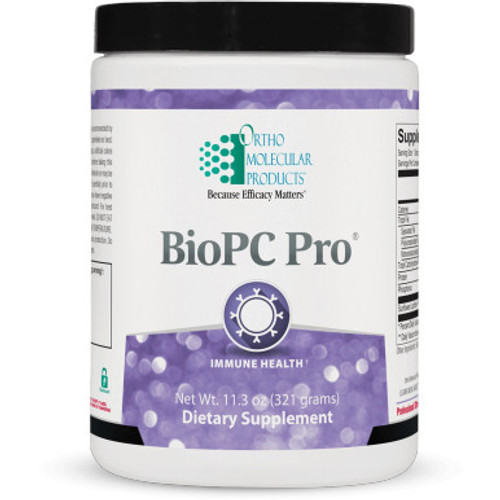BioPC Pro 30 SVG by Ortho Molecular Products
BioPC Pro 30 SVG by Ortho Molecular Products is a versatile health supplement that may have a plethora of potential health benefits.* For starters, you can take it as an immune support product, due to its impact on cellular function and mitochondrial health.* But, it can also aid your GI system due to its potential to strengthen the gastrointestinal barrier.* It may also have anti-inflammatory properties, further adding to the list of its potential health benefits.*
Who Should Consider BioPC Pro 30 SVG?
BioPC Pro 30 SVG by Ortho Molecular Products may support your health if you:
- often catch colds or infections*
- frequently experience unpleasant gastrointestinal symptoms*
- seek overall health support*
BioPC Pro 30 SVG by Ortho Molecular Products—Effects
BioPC Pro 30 SVG may support:
- your cellular health*
- your mitochondrial health*
- your immune response*
- your GI health*
- your inflammatory response*
Supplements support your health but do not replace a balanced diet. Always check with your healthcare practitioner if you have doubts about a new supplement. Book a FREE product consultation to learn more about BioPC Pro 30 SVG.
Recommendation:
Ortho Molecular Products suggests taking 1 scoop (10 grams) per day with a meal or as recommended by your health care professional. May be mixed in juice or shakes, or sprinkled on food.
Serving Size: 1 Scoop (10 grams)
Servings Per Container: About 30
Amount Per Serving:
Calories 60
Total Fat 5 g
Saturated Fat 1 g
Polyunsaturated Fat 3 g
Monounsaturated Fat 1 g
Total Carbohydrate 3 g
Protein <1 g
Sunflower Lecithin Powder 10 g
Phosphorus 130 mg
Other Ingredients: Mixed Tocopherols.
Typical naturally occuring phospholipid profile (per 10 g serving)‡:
Phosphatidylcholine 2.5 g (2,500 mg)
Phosphatidylinositol 2 g (2,000 mg)
Phosphatidylethanolamine 1 g (1,000 mg)
Phosphatidic acid 0.4 g (400 mg)
‡ subject to natural variability
Does Not Contain: Gluten, corn, yeast, artificial colors and flavors.
Cautions:
If you are pregnant or nursing, consult your physician before taking this product.
Click here to view Product Info Sheet
*These statements have not been evaluated by the FDA. This product is not intended to diagnose, treat, cure, or prevent any disease.
References:
- Nicolson, G. L., & Ash, M. E. (2014). Lipid replacement therapy: A natural medicine approach to replacing damaged lipids in cellular membranes and organelles and restoring function. Biochimica et Biophysica Acta, 1838(6), 1657–1679. https://doi.org/10.1016/j.bbamem.2013.11.010
- Furse, S., & de Kroon, A. I. (2015). Phosphatidylcholine’s functions beyond that of a membrane brick. Molecular Membrane Biology, 32(4), 117–119. https://doi.org/10.3109/09687688.2015.1066894
- Acoba, M. G., Senoo, N., & Claypool, S. M. (2020). Phospholipid ebb and flow makes mitochondria go. The Journal of Cell Biology, 219(8), e202003131. https://doi.org/10.1083/jcb.202003131
- Blaton, V., Vandamme, D., & Peeters, H. (1974). Activation of lipoprotein lipase in vitro by unsaturated phospholipids. FEBS Letters, 44(2), 185–188.
- Horsch, A. K., Hudson, K., & Day, A. J. (1977). Uptake and metabolism of 3H-fatty acid labelled lecithin by normal and atherosclerotic intima in vivo and in vitro. Atherosclerosis, 26(4), 493–504.
- Howard, A. N., & Patelski, J. (1974). Hydrolysis and synthesis of aortic cholesterol esters in atherosclerotic baboons: Effect of polyunsaturated phosphatidylcholine on enzyme activities. Atherosclerosis, 20(2), 225–232.
- Waligora, Z., Patelski, J., Brown, B. D., & Howard, A. N. (1975). Effect of a hypercholesterolaemic diet and a single injection of polyunsaturated phosphatidylcholine solution on the activities of lipolytic enzymes, acyl-CoA synthetase and acyl-CoA cholesterol acyl-transferase in rabbit tissues. Biochemical Pharmacology, 24(24), 2263–2267.
- Karaman, A., Demirbilek, S., Sezgin, N., Gürbüz, N., & Gürses, I. (2003). Protective effect of polyunsaturated phosphatidylcholine on liver damage induced by biliary obstruction in rats. Journal of Pediatric Surgery, 38(9), 1341–1347.
- Olbrich, K., Rawicz, W., Needham, D., & Evans, E. (2000). Water permeability and mechanical strength of polyunsaturated lipid bilayers. Biophysical Journal, 79(1), 321–327.
- Buko, V., Artsukevich, A., Maltsev, A., Nikitin, V., Ignatenko, K., Gundermann, K. J., & Schumacher, R. (1994). Effect of polyunsaturated phosphatidylcholine on lipid structure and cAMP-dependent signal transduction in the liver of rats chronically intoxicated with ethanol. Experimental and Toxicologic Pathology, 46(4–5), 375–382.
- Nicolson, G. (2003). Lipid replacement as an adjunct to therapy for chronic fatigue, anti-aging and restoration of mitochondrial function. The Journal of the American Nutraceutical Association, 6(3), 4–10.
- Nicolson, G. L., & Ellithorpe, R. (2006). Lipid replacement and antioxidant nutritional therapy for restoring mitochondrial function and reducing fatigue in chronic fatigue syndrome and other fatiguing illnesses. Journal of Chronic Fatigue Syndrome, 13(1), 57–68.
- Nicolson, G. L. (2005). Lipid replacement/antioxidant therapy as an adjunct supplement to reduce the adverse effects of cancer therapy and restore mitochondrial function. Pathology & Oncology Research, 11(3), 139–144.
- Zierenberg, O., & Grundy, S. M. (1982). Intestinal absorption of polyenephosphatidylcholine in man. Journal of Lipid Research, 23(8), 1136–1142.







